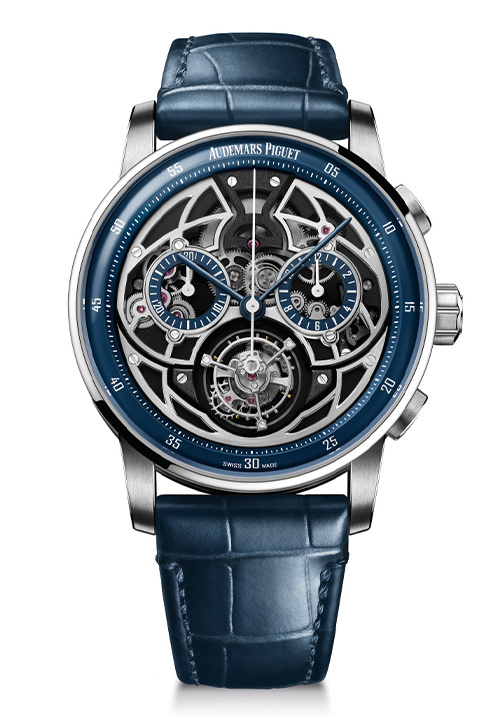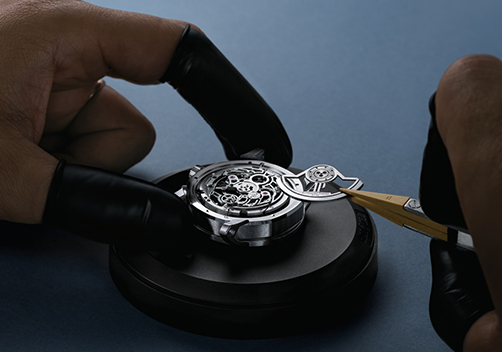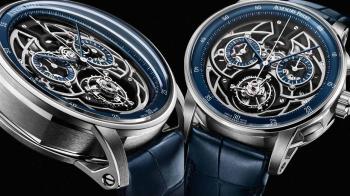A CONTEMPORARY TAKE ON TRADITION
The Swiss Haute Horlogerie manufacturer evolves the Code 11.59 by Audemars Piguet collection with a new Selfwinding Flying Tourbillon Chronograph. For the first time ever, Audemars Piguet dares to combine the classicism and prestige of the flying tourbillon with the modernity of the flyback chronograph – the sporting complication par excellence.
Limited to 50 pieces, this complex watch endowed with contemporary aesthetics and distinct architectural elements brings forward the Manufacture’s progressive approach to traditional craftsmanship.

STATE-OF-THE-ART ARCHITECTURE
"The thread that connects all of our products – past and present – is that our cases are the canvas for highly detailed hand-finishing that creates a play of light when one examines the case’s architectural geometry," say Michael Friedman Head of Complications, Audemars Piguet.
"The new Code 11.59 by Audemars Piguet Selfwinding Flying Tourbillon Chronograph amplifies this experience by emphasizing the contrast of light and the various finishing techniques of the openworked dial elements and the multi-layered complex mechanism. All aspects of the watch – case, dial and movement – are essential platforms for our watchmakers and artisans to express their craft and the continuing story of Audemars Piguet.”
This watch unites an 18-carat white gold case with a three-dimensional architectural face design blurring the line between dial and movement. The contrast of rhodium-toned and black galvanic openworked bridges honed from titanium and nickel silver, brings depth and play of light to the watch. The movement as well as all design elements, which count more than 100 hand-polished angles, are meticulously finished by hand with an alternation of satin-brushing and sandblasting.

The transparent chronograph counters at 3 and 9 o’clock reveal part of the complex mechanism, while the impactful flying tourbillon makes its rotation at 6 o’clock. The blued lacquered inner bezel, white gold hands and chronograph rings add a subtle touch of colour, which is enhanced by the watch’s dark blue hand-stitched alligator strap.
The complex double curved sapphire crystal, which integrates the geometry of the watch’s extrathin bezel, offers a unique perspective on the dial’s contemporary aesthetics and refined hand-finishing. The sapphire caseback reveals through its satinbrushed and sandblasted openworked bridges part of calibre 2952, the Manufacture’s newest selfwinding movement endowed with a flying tourbillon and a flyback chronograph.

AUDEMARS PIGUET, A PIONEER IN TOURBILLON WRISTWATCHES
Code 11.59 by Audemars Piguet Selfwinding Flying Tourbillon Chronograph continues to uphold the Manufacture’s pioneering development in terms of tourbillon wristwatches. The tourbillon invented by Abraham-Louis Breguet in 1801 was a rare find in pocket watches across the world and almost entirely absent from wristwatches before 1986. To this day, it has remained a symbol of watchmaking excellence and art as only a few watchmakers are trained to perfect this mechanism.
In the early 1980s, Georges Golay, Audemars Piguet’s General Director, challenged Serge Meylan, a young constructor newly arrived in the workshops, to give life to the first selfwinding tourbillon in the history of wristwatches – a considerable challenge as the movement had to fit in an ultra-slim 5.3 mm-thick case. Serge successfully met the challenge and this tourbillon is still one of the smallest in the world today with a diameter of 7.2 mm, as well as one of the lightest at just 0.123 grams. Introduced in 1986, this wristwatch forged a new path for the entire high-end watchmaking sector, which renewed ties with this complicated mechanism.
The Manufacture combined the tourbillon and the chronograph for the first time in 1999 in the Jules Audemars Tradition d’Excellence n°1 wristwatch – a limited edition of 20 pieces in platinum uniting tourbillon, chronograph and minute repeater in a movement entirely developed and produced inhouse. It was followed in 2003 by Audemars Piguet’s first chronograph tourbillon movement, hand-wound calibre 2889, launched in the Royal Oak collection (ref. 25977). Since then, this complicated movement has seen numerous evolutions across the Manufacture’s collections.

The Code 11.59 by Audemars Piguet Selfwinding Flying Tourbillon Chronograph represents, however, the first time this combination is evolved at Audemars Piguet with a flying tourbillon – a complicated mechanism which the Manufacture first released in 2018 in the Royal Oak Concept collection. By bringing together the chronograph and the flying tourbillon in its latest Code 11.59 by Audemars Piguet collection, the manufacturer continues to move ancestral craftsmanship forward by preserving and reinterpreting traditions.





